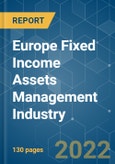Portfolio allocations to fixed income are primarily driven by investors' expectations of returns, followed by volatility concerns and liquidity requirements. Within core European fixed incomes, investment-grade corporate bonds are primarily used to deliver returns, while lower-yielding sovereign debt has a more operative function of liquidity and duration-matching. Non-core fixed income classes such as global high yield and emerging market debt are expected to deliver the strongest overall performance. Conversely, reflecting the return expectations noted above, global high yield and emerging market debt are sought-after sources of total return and yield generation.
European institutions are allocating, on average, 56% of their portfolios to fixed income and twice their allocation to equity. Two-thirds of European institutions manage their fixed income on a wholly active basis. However, there is a growing minority looking to manage core assets such as domestic government bonds passively, primarily using index funds. Half of the European institutions have a fixed income portfolio duration of five to ten years.
The COVID-19 pandemic shone a spotlight on the need to continue technological modernization at every level of the investment management delivery chain in order to deliver the best outcomes for customers. The operating model is also increasingly focused on the importance of the Diversity and Inclusion (D&I) agenda.
Europe is a world leader in the issuance of green bonds, with a total issuance of USD 265 billion in green bonds in 2021. Germany issued, by far, the largest amount of green bonds in Europe, amounting to over USD 63 billion. Since the European Investment Bank inaugurated the green bond market in 2007 with its Climate Awareness Bond, the market has grown very fast, but it still represents only about 3 to 3.5% of overall bond issuance. The green bond market needs to grow more quickly to achieve the targets of the Paris Agreement. The Commission's proposal aims to establish an official EU standard for green bonds aligned with the EU taxonomy for sustainable activities, based on a registration system and supervisory framework for external reviewers of European green bonds.
The bond market has seen considerable increases in overseas allocation from 42% of total assets in 2017 to 55% in 2020. UK gilts and non-gilts (primarily made up of corporate bonds) outperformed global bonds, returning 9% and 8%, respectively. Growth in allocation to overseas bonds coincided with the United Kingdom’s decision to exit the European Union. Total investments across UK equities, sterling corporate bonds, UK infrastructure, and commercial property stood at EUR 1.7 trillion in 2020.
The report includes an overview of asset managers operating across Europe or in one or a few countries within the region. The report covers detailed profiling of a few major companies, including their product offerings, regulations governing them, their headquarters, and financial performance. Some of the major players currently dominating the market are listed below.
This product will be delivered within 2 business days.
European institutions are allocating, on average, 56% of their portfolios to fixed income and twice their allocation to equity. Two-thirds of European institutions manage their fixed income on a wholly active basis. However, there is a growing minority looking to manage core assets such as domestic government bonds passively, primarily using index funds. Half of the European institutions have a fixed income portfolio duration of five to ten years.
The COVID-19 pandemic shone a spotlight on the need to continue technological modernization at every level of the investment management delivery chain in order to deliver the best outcomes for customers. The operating model is also increasingly focused on the importance of the Diversity and Inclusion (D&I) agenda.
Key Market Trends
Green Bonds in Europe Driving the Market
Europe is a world leader in the issuance of green bonds, with a total issuance of USD 265 billion in green bonds in 2021. Germany issued, by far, the largest amount of green bonds in Europe, amounting to over USD 63 billion. Since the European Investment Bank inaugurated the green bond market in 2007 with its Climate Awareness Bond, the market has grown very fast, but it still represents only about 3 to 3.5% of overall bond issuance. The green bond market needs to grow more quickly to achieve the targets of the Paris Agreement. The Commission's proposal aims to establish an official EU standard for green bonds aligned with the EU taxonomy for sustainable activities, based on a registration system and supervisory framework for external reviewers of European green bonds.
Bond Market in United Kingdom Aiding Market Growth
The bond market has seen considerable increases in overseas allocation from 42% of total assets in 2017 to 55% in 2020. UK gilts and non-gilts (primarily made up of corporate bonds) outperformed global bonds, returning 9% and 8%, respectively. Growth in allocation to overseas bonds coincided with the United Kingdom’s decision to exit the European Union. Total investments across UK equities, sterling corporate bonds, UK infrastructure, and commercial property stood at EUR 1.7 trillion in 2020.
Competitive Landscape
The report includes an overview of asset managers operating across Europe or in one or a few countries within the region. The report covers detailed profiling of a few major companies, including their product offerings, regulations governing them, their headquarters, and financial performance. Some of the major players currently dominating the market are listed below.
Additional Benefits:
- The market estimate (ME) sheet in Excel format
- 3 months of analyst support
This product will be delivered within 2 business days.
Table of Contents
1 INTRODUCTION
4 MARKET INSIGHTS AND DYNAMICS
5 MARKET SEGMENTATION
6 COMPETITIVE LANDSCAPE
Companies Mentioned (Partial List)
A selection of companies mentioned in this report includes, but is not limited to:
- Legal & General Investment management
- JP Morgan
- Franklin Templeton
- BlackRock
- Insight Investment
- APG
- Amundi Investment
- State Street Global Advisors
- Goldman Sachs
- PIMCO*
Methodology

LOADING...








